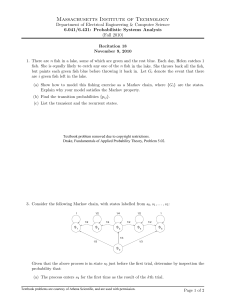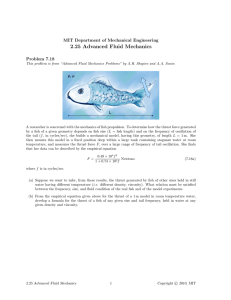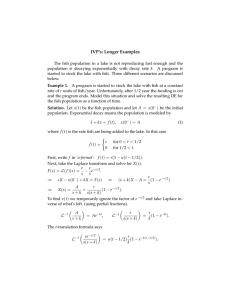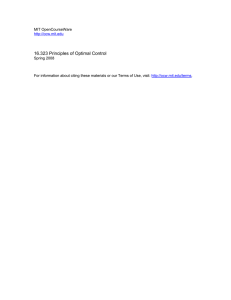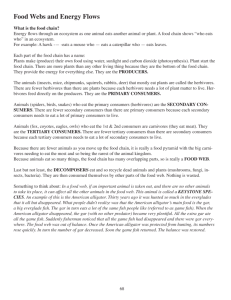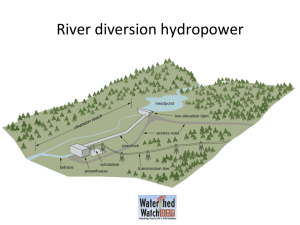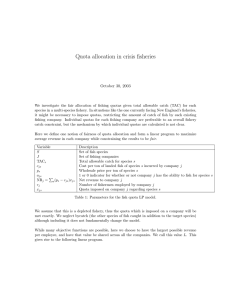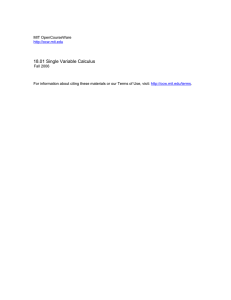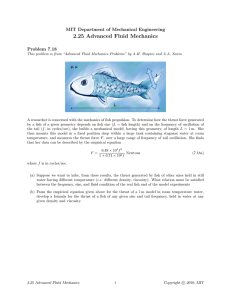A Predator-Prey Model with Disease Dynamics ∗† Chris Flake Tram Hoang
advertisement
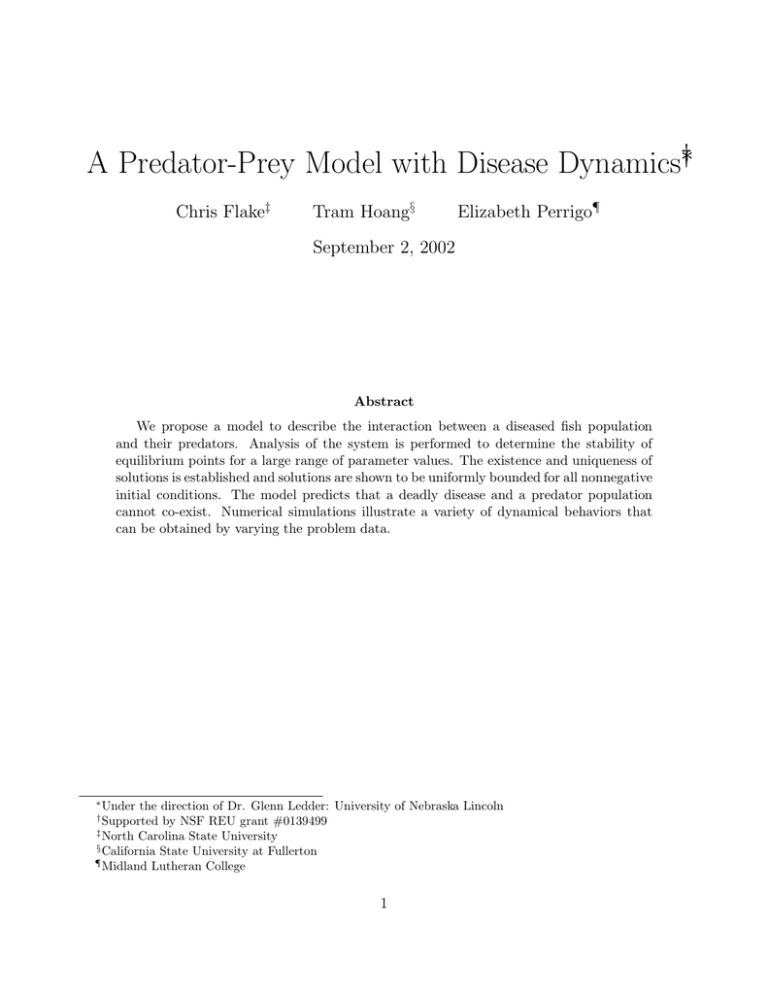
A Predator-Prey Model with Disease Dynamics∗†
Chris Flake‡
Tram Hoang§
Elizabeth Perrigo¶
September 2, 2002
Abstract
We propose a model to describe the interaction between a diseased fish population
and their predators. Analysis of the system is performed to determine the stability of
equilibrium points for a large range of parameter values. The existence and uniqueness of
solutions is established and solutions are shown to be uniformly bounded for all nonnegative
initial conditions. The model predicts that a deadly disease and a predator population
cannot co-exist. Numerical simulations illustrate a variety of dynamical behaviors that
can be obtained by varying the problem data.
∗
Under the direction of Dr. Glenn Ledder: University of Nebraska Lincoln
Supported by NSF REU grant #0139499
‡
North Carolina State University
§
California State University at Fullerton
¶
Midland Lutheran College
†
1
1
Introduction
We consider a model proposed by Chattopadhyay and Bairagi[?]: a system of three nonlinear
ordinary differential equations describing disease and predation among the Tilapia fish of the
Salton Sea and their predator, the pelican. This model is of interest because it combines a two
compartment epidemic model with a standard predator-prey model.
Since mid-August of 1996, a bacterial outbreak of Vibrio vulnificus in the Salton Sea among
the Tilapia has led to massive deaths not only among the fish themselves, but also in the pelican
population. Studies have indicated that the bacterial infection contributes to low oxygen levels
in the tissues of the infected fish. The shortage of oxygen causes the fish to seek oxygen from
the sea’s surface and leads to a favorable environment for botulism to grow in the tissues of
the infected fish[?]. When pelicans prey upon these vulnerable fish, it is likely that they ingest
the botulism toxins that eventually contribute to the development of Avian botulism. Avian
botulism is a debilitating neurological disease which usually inflicts death upon its host[?].
Environmental stressors have been targeted as the probable cause of this situation. Extremely high temperature, massive algae growth, high salinity, pollution, and low dissolved
oxygen levels are all conditions which can lead to epidemics[?]. In this paper we neglect the initial cause of the outbreak and focus on the dynamics and interactions of the sick and susceptible
fish with the pelicans.
The model of Chattopadhyay and Bairagi is based on these assumptions:
(1) The prey are divided into two disjoint classes, susceptible fish, S, and infected fish, I;
(2) In the absence of predation and infection, the fish population grows logistically;
(3) Infected fish are unable to reproduce due to short lifespan and infected fish do not recover;
(4) Infection impairs fish defenses, therefore pelicans eat only infected fish; a Holling type II
predation rate is used for infected fish;
(5) Pelicans die at a constant relative rate due to infected fish consumption and therefore die
at a constant relative rate overall.
One limitation of their model is that eating infected fish must be more beneficial than harmful.
This paper deals with the case where eating infected fish does more harm than good.
In our paper we alter assumptions (4) and (5) to generalize and thus more accurately describe
natural dynamics. It seems more likely that the pelicans will consume whatever is available,
be it sick or susceptible fish. The infected fish are more likely to be preyed upon by pelicans
because the infection has been found to impair fish defense mechanisms as well as forcing the fish
to seek oxygen on the sea’s surface. Since botulism is an accumulative sickness it is reasonable
to presume that the pelicans’ death rate is not constant, but rather proportional to the number
of sick fish ingested[?]. We develop these assumptions into a model and then find and classify
its equilibrium points. Numerical experiments are then carried out to confirm and visualize the
equilibrium analysis.
2
2
The Model and Equations
In the development of our model, we first considered the typical SI model in which two
populations of fish exist: susceptible fish, S, and infected fish, I. A typical SI model with an
open system of variable size is
Ṡ = − λSI − ρS,
I˙ = λSI − µI.
where represents the birth rate, λ the infection rate multiplied by transmission probability, ρ
the natural death rate for the susceptible fish, and µ the death rate due to infection. This model
assumes that the disease is transmitted by contact between an infected fish and a susceptible fish,
and that all susceptible fish are equally susceptible and all infected fish are equally infectious.
2.1
Predation Term
We then attempted to incorporate the standard predator-prey model with Holling Type II
predation into our model. A common predator-prey model with Holling Type II predation can
be expressed as
N
mNP
−
,
Ṅ = rN 1 −
K
γ+N
Ṗ =
CmNP
− dP.
γ+N
where N denotes the fish population and P the pelicans. In the absence of predation, the
fish population, N, grows logistically with carrying capacity K. In this system, m denotes the
search rate, C the conversion factor, and γ the half saturation coefficient. These equations only
successfully model a system in which a single predator feeds upon a single prey. Considering our
new assumptions, namely the assumption that the pelicans eat both infected and susceptible
fish, the Holling Type II predation term does not suffice. This caused us to develop a new
predation term which accounted for the pelicans’ consumption of both infected and susceptible
fish.
In the development of our new predation term, we refer to work by C.S. Holling[?] in which
he described the dynamics of the consumption of prey by predators as the density of the prey
changes. We expand his model to account for a system in which a single predator feeds upon
two types of prey, specifically infected and susceptible fish.
In his 1959 paper, Holling devised an experiment in which blindfolded human subjects represented the predator and uniformly sized sandpaper disks corresponded to the prey. The human
subject was placed in front of a 3 by 3 foot table to which the sandpaper disks were attached.
The experimental process required the “predator” to search for the “prey” by tapping on the
table. When a disk was located the “predator” picked it up and placed it in a pile; this represented handling time. The procedure was repeated for a given period of time, and the results
were recorded. Holling described these results with the following equation:
3
y = aTs x,
where y is the total number of collected disks, a is the rate of searching multiplied by the
probability of finding a disk, Ts is the available search time, and x is the density of the disks.
The search time, TS , is found from taking the total time and subtracting the total handling
time, where b is the handling time per fish. This is expressed as
Ts = Tt − by.
Substitution yields the standard Holling Type II predation formula
y=
Tt ax
.
1 + abx
To find a predation term that reflects our assumption that the pelicans consume both infected and susceptible fish, we follow the steps in Holling’s experiment. We require that the
sandpaper disks consist of two distinct sizes. Studies have indicated that the infected fish are
more vulnerable to predation due to their illness[?]; therefore, we let the larger disks correspond
to the infected fish, and the smaller disks to the susceptible fish. Recall that in Holling’s experiment, the parameter a is the rate of searching times the probability of finding a disk. We
consider that the probability of finding a particular disk depends on the area of the disk. This is
a reasonable assumption since the chances of finding any particular disk on a table corresponds
directly to the size of the disk. The predation rates for susceptible and infected fish are then
yS = aS Ts S,
yI = aI Ts I,
(1)
where aS and aI are the area of each respective disk. To take into account the vulnerability of
the infected fish, we make the infected disks larger than the susceptible by a vulnerability factor
of v, where v > 1. Setting a = aS we can simplify aI = vaS = va, which simplifies eqs. ?? to
yS = aTs S,
yI = vaTs I.
(2)
The susceptible and infected fish are of the same species, so it is reasonable to consider that
they require the same amount of handling time, b. Considering Tt to be unit time yields the
following expression for search time
Ts = 1 − b(yS + yI ).
(3)
Substituting eq. ?? into eqs. ??, we obtain the ystem
1 + abS
ab
yS
aS
=
,
yI
vaI
vab
1 + vabI
with solutions
yS =
aS
,
1+ab(S+vI)
yI =
4
vaI
.
1+ab(S+vI)
To aide in scaling, we change the parameters to = 1/b and γ = 1/ab. This yields the new
solutions
yS =
S
γ+S+vI ,
yI =
vI
γ+S+vI ,
Our new parameters and γ now correspond respectively to the amount of handled fish in unit
time and the number of searches per unit time.
2.2
Pelican Death Rate
We assume that pelicans die at a rate proportional to the amount of infected fish consumed.
This requires the addition of a death rate which incorporates both our new predation term and
the natural relative death rate, which can be considered constant. Accordingly, we define the
relative death rate of pelicans to be
1 dP
= − (ψyI + d) .
P dt
Here d is the natural death rate and ψ is the pelican death rate due to infection per ingested
fish.
2.3
Model Formulation
Putting the pieces of our model together we obtain the following differential equations
S+I
SP
Ṡ = rS 1 −
−
− λSI,
K
γ + S + vI
I˙ = λSI −
Ṗ =
vIP
− µI,
γ + S + vI
θ(S + vI)P
ψvIP
− dP −
.
γ + S + vI
γ + S + vI
The birth/death rates in the SI model are built into the parameters r and K in Ṡ. Thus, r
denotes the maximum growth rate of fish, θ the conversion factor for the pelicans, and all other
parameters have been previously defined.
Before analyzing our system, it is convenient to scale our equations. By writing a model in
dimensionless form, we are able to reduce the number of parameters. We choose our scale for S
and I to be K because we want our maximum population to be 1. We pick our scale for P to
be rγ/, and our timescale to be r. Implementing these scales into our model we are left with
the following system in Kolmogorov form[?]:
5
ṡ = sf (s, i, p),
(4)
i̇ = ig(s, i, p),
ṗ = ph(s, i, p),
with
f (s, i, p) = 1 − s − (1 + β)i −
Γp
,
Γ + s + vi
vΓp
,
Γ + s + vi
s + v(1 − η)i
h(s, i, p) = c
−e ,
Γ + s + vi
g(s, i, p) = β(s − α) −
where
β =
λK
,
r
c =
θ
,
r
η =
ψ
,
θ
e =
d
,
θ
α =
µ
,
λK
Γ =
γ
.
K
The parameters now have the following physical interpretations:
β: Rate constant for disease transmission;
Γ: Half-saturation point of our predation term;
v: Vulnerability of infected fish relative to susceptible fish;
α: Non-predation death rate of infected fish relative to the infection rate;
c: Ratio of population grouth rate of pelicans to that of fish;
η: Harm for pelicans eating infected fish;
e: Per capita pelican death rate relative to the growth rate.
3
The Analysis and Mathematical Results
Here we deal with the existence and stability of equilibrium points. Throughout the rest of
the paper we assume that η > 1. This assumption is reasonable considering that eating infected
fish is harmful to pelicans. The existence and uniqueness of solutions is established and the
solutions are shown to be uniformly bounded.
6
3.1
Equilibrium Analysis
Setting all derivatives of system ?? equal to zero we find the following five equilibrium points,
named by the nontrivial variables:
T ≡ (0, 0, 0)
S ≡ (1, 0, 0)
,
0
SI ≡ α, 1−α
1+β
1−e(Γ+1)
Γe
SP ≡
, 0, (1−e)2
1−e
The last equilibrium point SIP can be found by solving the following system of 3 equations:
β+v
v(1 + β)
s
v + βα
=
,
(6)
(1 − e) v(1 − η − e)
i
Γe
p=
β(Γ + s + vi)(s − α)
.
vΓ
We use the convention R0,+ ≡ (R ∪ {0}). Since we are working in R30,+ we need to check
which parameter values allow the equilibria to exist. It is easy to see that T and S exist for all
1
parameter values. SI exists when α < 1. Similarly, SP exists when e < Γ+1
. Note here that the
disease can’t persist if the death rate of infected fish is too high. Similarly, the predator can’t
survive if it’s death rate is too high.
3.1.1
Existence of SIP
The interior equilibrium point, SIP = (S, I, P), exists when S, I, P ∈ R+ . In order to have
P > 0, we must have
1 − S − (1 + β)I > 0 and β(S − α) > 0
Let D = {(s, i) ∈ R2+ | s > α and s + (1 + β)i < 1}. In order for SIP to exist, we must
ensure that (S, I) ∈ D. The linear system ?? yields unique solutions for (S, I) when η > 1. The
first part of system ?? gives the equation (β + v)S + v(1 + β)I = v + βα. Since D is convex,
and the graph of the last equation enters D at a vertex, then showing (S, I) ∈ D is equivalent
to showing that 0 < I < 1−α
. Thus SIP exists whenever:
1+β
E1 ≡
α(1 + β) + v(1 − η)(1 − α)
v + βα
<e<
≡ E2
(Γ + α)(1 + β) + v(1 − α)
(v + βα) + Γ(v + β)
(7)
1
Γ+1
The parameters α and e are recognized to be important from the criterion for the existence
of equilibria. The existence regions for the equilibria are depicted schematically in Figure 1.
α < 1 and e <
7
Figure 1: Regions of equilibria existence in (α, e) space
3.2
Stability and Boundedness
Next we find where these equilibria are stable. Standard linearization techniques confirm
that T is a saddle for all parameter values and that S is locally stable whenever α > 1 and
1
e > Γ+1
.
Claim 1 The equilibrium SI is locally stable whenever e > E1 and α < 1.
The Jacobian for the system at SI is
−α −α(1 + β)
(1−α)β
0
J(SI) = 1+β
0
0
The eigenvalues of this matrix are λ1 =
sfp
igp
(1+β)(α−eΓ−eα)+v(1−α)(1−η−e)
(1+β)(Γ+α)+v(1−α)
(1+β)(eΓ+eα−α)+v(1−α)(η+e−1)
,
(1+β)(Γ+α)+v(1−α)
.
and λ2,3 =
−α±
√
α2 −4(α−α2 )β
.
2
e > E1 ⇐⇒ λ1 < 0.
(λ2,3 ) < 0 as long as α2 − 4(α − α2 )β < α2 holds; this is clearly true for α < 1. Thus we have
that SI is locally stable under the given conditions.
8
Claim 2 The equilibrium point SP is locally stable whenever
The Jacobian for the system at SP is
J(SP) =
e(Γ+Γe+e−1)
e−1
0
c(1−Γe−e)
Γ
An eigenvalue of this matrix is λ1 =
from the matrix
sfi
v(1−Γe−e)+β(α−αe−Γe)
e−1
cphi
v(1−Γe−e)+β(α−αe−Γe)
.
e−1
J2,2 =
1−Γ
Γ+1
1
< e < min{ Γ+1
, E2 }.
−Γe
0 .
0
The other two eigenvalues are found
e(Γ+Γe+e−1)
e−1
−Γe
c(1−Γe−e)
Γ
0
e < E2 ⇐⇒ λ1 < 0.
The Routh-Hurwitz Criterion[?] for a 2 × 2 matrix states that the eigenvalues will have
negative real parts whenever det(J2,2 ) > 0 and trace(J2,2 ) < 0.
e<
1
⇐⇒ det(J2,2 ) > 0,
1+Γ
1−Γ
⇐⇒ trace(J2,2 ) < 0.
1+Γ
Since all eigenvalues of J(SP) have negative real part, we have that SP is locally stable with
the given conditions.
e>
Claim 3 The interior equilibrium point SIP is unstable everywhere that it exists.
Sfs
Sfi Sfp
Igi Igp
J(SIP) = Igs
cPhp cPhi 0
Given that gp = vfp , we have
det(J(SIP)) = (−cSIPfp )(vfs hi + gi hs − vfi hs − gs hi )
After quite a bit of computation, it can be shown that
vfs hi + gi hs − vfi hs − gs hi =
9
η(1 + β)
>0
Γ + s + vi
and
−Γ
< 0.
Γ + s + vi
Thus det(J(SIP)) > 0. The Routh-Hurwitz criterion for 3 × 3 matrices says there will be
at least one eigenvalue of J(SIP) that will have a non-negative real part. This allows us to
conclude that SIP is an unstable equilibrium point in the region where it exists.
fp =
Figure 2 shows where, in the (α, e) plane, the different equilibria are stable.
Figure 2: Regions of equilibria stability in (α, e) space. l.c. refers to a limit cycle around the
corresponding equilibrium point.
3.2.1
Existence, Uniqueness and Boundedness
Equations ?? can be written in the form
ẏ = F (y)
(8)
where y = (s, i, p), yo = (s(0), i(0), p(0)) and F (y) = (f (s, i, p), g(s, i, p), h(s, i, p)).
Lemma 1 The solution y(t) exists and is unique ∀t ∈ R0,+ when yo ∈ R30,+ .
Proof: Clearly F (y) ∈ C(R30,+ ) since Γ > 0. By assumption yo ∈ R30,+ . Showing that F satisfies
a Lipschitz condition on R30,+ is equivalent to showing that D(F ) ∈ C(R30,+ )[?].
10
f + sfs
sfi
sfp
.
D(F ) = J(F (s, i, p)) = igs
g + igi
igi
cphs
cphi ch + cphp
Once again, the only possible problem comes from the denominator Γ + s + vi. Since Γ > 0, we
have that F satisfies a Lipschitz condition on R30,+ . Therefore by an existence and uniqueness
theorem[?], the solution y(t) exists and is unique and can be extended to all of R0,+ .
Theorem 1 The solution y(t) is uniformly bounded for yo ∈ R30,+ .
Proof: Define k : R0,+ → R0,+ by k(t) = s(t) + i(t) + Γc p(t). k is well defined and differentiable
by Lemma 1. Differentiating k with respect to system ?? yields
vηi
k̇ = s(1 − s) − i(αβ + s) − Γp
+e .
Γ + s + vi
Let > 0 be some positive number.
vηi
k̇ + k = s(1 − s + ) − i(αβ + s − ) − Γp
+e−
.
Γ + s + vi
c
The maximum value of s(1 − s + ) on R0,+ is
(1+)2
.
4
Therefore
(1 + )2
k̇ + k ≤
− i(αβ − ) − Γp e −
.
4
c
Choose 0 < < min{αβ, ce}. Then ∃ B > 0 such that
k̇ + k ≤ B for each t ∈ R0,+ .
Let G(t, y) = B −y, which satisfies a lipschitz condition everywhere. Clearly k̇(t) ≤ B −k(t) =
G(t, k(t)) for all t ∈ R0,+ . Let ṙ = G(t, r) = B − r and r(0) = k(0) = ko . This ordinary
differential equation has the solution
B
(1 − e−t ) + ko e−t .
It is clear that r(t) is bounded on R0,+ . By the comparison theorem[?]:
r(t) =
B
(1 − e−t ) + ko e−t ∀t ∈ R0,+ .
Therefore k(t) must be bounded for all non-negative t, and thus y(t) is uniformly bounded on
R0,+ .
k(t) ≤ r(t) =
11
4
Numerical Results
In this section we use numerical experiments to confirm and visualize the equilibrium analysis. We go through the regions where there are interesting dynamics, and shed new light on
their physical meaning. We used a fourth order Runga-Kutta implementation on MATLAB to
numerically solve our equations.
4.1
Dynamics of Region 3
In the arc between the two curves E1 and E2 , both SI and SP are feasible equilibrium
points for various initial conditions. To illustrate the effect that initial conditions have on the
convergence toward equilibrium points, we choose a value of α and e which lies within region 3.
By fixing all other parameters and choosing two distinct initial conditions on the IP -plane we
developed the following systems of graphs.
Figure 3: Graphs describing the dynamics of region 3. The (α, e) plane (a), initial conditions
(b), and corresponding solutions for c = 0.2, e = 0.6, v = 5, Γ = 0.5, α = .1, β = 1, η = 1.5,
and initial conditions (0.5, 0.2, 0.7) in normal and (0.5, 0.8, 0.1) in bold.
Since each initial condition converges to separate equilibria, we conclude that the position
12
of the initial conditions determines the equilibrium point to which they converge. We can also
infer from our graphs that there must exist a surface in SIP space that seperates the domains
of attraction of the SI and SP equilibrium points. The unstable equilibrium point, SIP, is in
that surface.
4.2
Dynamics in Region 5
When the parameter e falls below 1−Γ
the dynamics of the system change slightly. In order
Γ+1
to illustrate how the system behaves, we chose a point (α, e) which lies in region 5. Maintaining
all other parameter values and initial conditions, we obtain the following results.
Figure 4: Graphs describing the dynamics in region 5. Choosing e = 0.1 and α = 0.1 to correspond to a point in region 5. Initial conditions and other parameter values remain unchanged.
Both initial conditions move towards separate equilibrium points similar to the preceding
case. However, in this situation one initial condition converges to SI whereas the other approaches a limit cycle around SP. This still implies the existence of a surface seperating the
domains of attraction for the stable behaviors.
13
4.3
Dynamics in Region 6
Varying the point (α, e) to lie below E1 and the line
region 6.
1−Γ
,
Γ+1
we can observe the dynamics within
Figure 5: Graphs describing the dynamics in region 6. All parameter and initial condition values
are the same as the previous cases. Only the point (α, e) has been modified to be (0.8, 0.1).
In this scenario both initial conditions lead to limit cycles around SP . Our results show that
if the infection is very damaging to the sick fish, then they will soon die out and eventually the
susceptible fish and pelicans prevail. This is the same behavior that occurs in the equivalent
predator-prey system without disease[?].
4.4
Effect of β
Prior to the first major bird kill, environmental conditions of the sea apparently allowed for
the co-existence of pelicans and uninfected fish. This corresponds to a region in which the SP
equilibrium point is stable. If the environmental state were to change such that the infection
rate, β increases, it is possible that the conditions could change so that SP is no longer stable.
Pollution is one factor which has been shown to increase the infection rate for a variety of fish
diseases[?].
14
To demonstrate the effect of β, let us pick a point, say A, in region 3 and assume that
initially SP is the stable equilibrium. Let us also assume Γ and e are known and that all other
parameters are fixed. As pollution is introduced into the sea, the infection rate increases (this
corresponds to changes in β along the vertical axis of the graph), causing the curve E2 to shift
downward thus decreasing the area of region 3. As this occurs, point A is no longer inside
region 3 and now exists in region 1, where only SI equilibrium is stable, meaning the pelicans
will certainly die out. This is consistent with what one would expect to occur in nature. It
has been suggested that reducing the number of infected fish may be a means of maintaining
the pelican population[?]. However, according to our results, a change in the initial conditions
alone will not suffice because point A will converge to SI regardless, as it lies in a region of the
parameter space where only SI is stable. One would have to alter certain parameter values,
such as β, e, or α to return point A to region 3 and possibly adjust the initial conditions such
that convergence to SP is guaranteed.
Figure 6: Graphs describing the effect of β. While η is fixed, β varies. Let point A correspond
to *, where α = 0.1 and e = 0.6. The other parameter values are Γ = 0.5, v = 5, c = 0.2, and
η = 4.
5
Conclusion
The principle result of the analysis is that, given the harmful effect of infected fish on pelicans
(η > 1), the pelicans cannot coexist with the infected fish; mathematically this corresponds to
the lack of a stable SIP equilibrium. This lack of coexistence of I and P is caused by the
properties that gp < 0, which implies that P is bad for I, and hi is proportional to 1 − η,
meaning that I is bad for P (with η > 1). Biologically, the lack of IP co-existence can be
attributed to direct competition, where the pelicans and infection “prey” upon the susceptible
fish. With this direct competition, both “predators” are also harming each other, and only one
can prevail. In our analysis, a movement from region 3 to region 1 indicates a definite change in
the convergence of equilibrium points. This initiates the start of the epidemic and the eventual
extinction of the pelicans. We speculate that this shift is the result of pollution, as the increase
in pollution weakens the immunity of the fish making them susceptible to infection. A remedy
for this situation would require a restoration of the lake and possible removal of infected fish.
This should result in a return to region 3 and SP convergence. For purely mathematical interest,
15
one may desire to analyze the situation where it is less harmful for pelicans to consume infected
fish (i.e. η < 1); this may correspond to diseases other than Avian botulism.
References
[1] Birkhoff, G. and G. Rota. Ordinary Differential Equations, 4th ed. Canada: John Wiley &
Sons, Inc., 1989.
[2] Brauer, F. and C. Castillo-Chavez. Mathematical Models in Population Biology and Epidemiology. New York: Springer-Verlag New York, Inc., 2001.
[3] Bridges, D.S. Foundations of Real and Abstract Analysis. New York: Springer-Verlag New
York, Inc., 1998.
[4] Chattopadhyay, J. and N. Bairagi. “Pelicans at risk in Salton Sea - an eco-epidemiological
model.” Ecological Modelling 136 (2001): 103-112.
[5] Holling, C.S. “Some characteristics of Simple Types of Predation and Paratism.” Canadian
Entomologist 91 (1959): 385-398.
[6] Kuperman, B.I. and V.E. Matey. “Massive infestation by Amyloodinium ocellatum (Dinoflegellida) of fish in a highly saline lake, Salton Sea, California, USA.” Diseases of Aquatic
Organisms 39 (1999), pp. 65-73.
[7] Lafferty, K.D. and A.K. Morris. “Altered behavior of parasitized killifish increases susceptibility to predation by bird final hosts.” Ecology 77(5) (1996): 1390-1397.
[8] Miller, R.K. and A.N. Michel. Ordinary Differential Equations. New York: Academic Press,
Inc., 1982.
[9] Rocke, T, et al. “Environmental Characteristics Associated with the Occurrence of Avian
Botulism in Wetlands of a Northern California Refuge.” Journal of Wild-life Management
63(1) (1999): 358-368.
[10] Schaperclaus, W. Fish Disease, vol. I. New Dehli: Amerind Publishing Co., 1991.
[11] Walter, W. Ordinary Differential Equations. New York: Springer-Verlag New York, Inc.,
1998.
16
